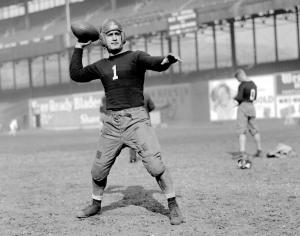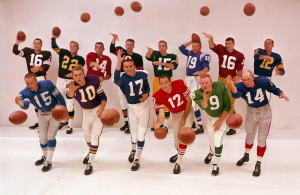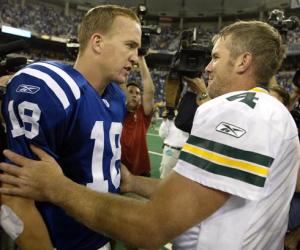Friend-of-the-program Bryan Frye has contributed a fantastic guest post for us today. Bryan lives in Yorktown, Virginia, and operates his own great site at http://www.thegridfe.com/, where he focuses on NFL stats and history. Be sure to check out Bryan’s site, and let him know your thoughts on today’s posts in the comments.
Last Sunday, Peyton Manning broke the record for career touchdown passes. You may have heard about it. Rather than add more flotsam and jetsam to the vast sea of internet articles dedicated to Manning, I thought I would instead focus on the rich history of the record itself.
Looking back at the previous record holders not only gives you an appreciation for the rich history of the NFL, but it also gives you great understanding of the evolution of the passing game. With rules changes, schematic evolution, sophisticated diet and workout regimens, and passing camps allowing kids to hone their skills before they can even do long division, modern quarterbacks are able to put up stats that dwarf those of their predecessors. [1]Not to mention the fact that modern players don’t also have to work full-time jobs to support their families and can devote real attention to the game. My grandfather lived in Baltimore as a young … Continue reading
In all of the ado surrounding five-oh-nine, there was not a great deal of attention given to the legends who held the prestigious record in bygone eras. The explosion of the passing game likely has much to do with football becoming America’s most popular sport. But let us not lose sight of an era when 230 pound linemen with names like Bulldog played their hearts out for a sport that didn’t even pay the bills. In an age when controversies are ubiquitous, there is something beautiful about that kind of purity.
The Record Holders
Given the inconsistencies in the statistics of the league’s Paleolithic Era, the trip down memory lane will begin with Friedman. [2]With all due respect to Pudge Wyman, who was the original record-holder when he threw the NFL’s first-ever touchdown pass on October 10, 1920. He played for the Bulldogs, Wolverines, Giants, and Dodgers between 1927 and 1934. During that time, he is credited with throwing 66 touchdown passes. As a testament to statistical irregularities, that number is often presented as 67, depending on the writer. The most contention is over his total in 1929, when he threw either 20 or 21 touchdowns (either of which is incredible for 1929). I’m going with 66 based on research by Joel Bussert. [3]Note that Pro Football Reference lists 20 on Friedman’s main page and 21 on his touchdown log page. Using Bussert’s number, Friedman threw his 66th and final touchdown pass on October 10, 1933. He would be the sole record holder for seven seasons.
On November 11, 1940, Green Bay’s Arnie Herber threw his 66th touchdown pass to tie the record. The emergence of Cecil Isbell kept Herber from breaking the record, as Isbell and Hal Van Every threw the Packers’ only touchdowns for the remainder of the season. Herber retired following the 1940 season, but he came out of retirement to play for the Giants from 1944-1945. Unfortunately for the Green Bay legend, another icon had already run away with the record by that point.
Slingin’ Sammy may have been the first genuine superstar quarterback. Along with Sid Luckman, Baugh used the T-formation to lead the league’s first great passing revolution. [4]Similar to the innovative offenses of Bill Walsh and Don Coryell, Clark Shaughnessy’s version of this offense led to increases in both volume and efficiency of the passing game. Not only was he a champion, but he also was the first passer to eclipse the century mark for touchdowns. He broke the previous record on October 31, 1943 — on a day when he threw six touchdowns — and didn’t stop until he reached 187 in 1952. Sixty-two years have passed, and he remains Washington’s career touchdown leader. [5]The reason for this basically is one part Baugh’s greatness, one part Washington’s inability to find a good quarterback, and one part Lawrence Taylor. To date, Baugh is the second-longest reigning touchdown king, holding the record for nearly 19 years.
Layne’s last touchdown pass of the 1961 season tied him for the record with 187, but he would not have the record to himself until September 23, 1962. He added eight more touchdowns to his total, retiring with 196. Despite once owning the record, Layne is best known for winning three titles and being the original master of the two-minute drill. This is likely due to the brevity of his place in the record books; he only wore the crown for a little over a year, giving him the distinction of having the shortest reign of any touchdown king.
Y.A. TittleOn December 1, 1963, Tittle became the second Giants quarterback to own the passing touchdown record. [6]Note that this excludes 30 touchdown passes he threw for the AAFC’s Baltimore Colts. Even after a great decade with the 49ers, Tittle did not appear anywhere close to breaking the record. However, he broke the NFL’s single-season touchdown record with 33 in 1962 [7]This excludes the 36 touchdowns George Blanda threw for the 1961 Houston Oilers. Including later AFL stats is not a problem, but including early AFL stats doesn’t feel right to me. and then broke his own record by throwing 36 the following year. Adjusting for era, these have to be considered two of the best “old man” seasons in league history. [8]And they’re pretty good even if you ignore age, too. With his late career resurgence, Tittle ended with 212 NFL touchdown passes and held the record for three seasons.
Johnny Unitas
In much the same way Baugh obliterated the previous touchdown record, Unitas took the existing record to an almost mythical level. After breaking the record on September 18, 1966, the original Johnny Football didn’t rest until he reached 290 touchdown passes. When you consider the passing environment of his era, the fact that his 290 scoring passes still ranks ninth all-time is a testament to his greatness. Unitas went on to hold the record for nine years.
Perhaps the most underrated quarterback in the Hall of Fame, Tarkenton put up incredible numbers for the Vikings, Giants, and Vikings again. He broke Unitas’ record on the last day of the 1975 regular season; he then went on to become the first quarterback ever to throw for more than 300 touchdowns, finishing with 342. Not bad for a guy known as a diminutive Scrambler. Despite playing half his career in the NFL’s dead-ball era, he held the record for an astonishing 19 years, 11 months. [9]When you consider Dan Fouts under Coryell and Joe Montana under Walsh, among other Eighties passing attacks, Tarkenton’s numbers are even more impressive.
Marino waged his greatest assault on the record books early in his career, throwing an incredible 122 touchdowns between his second and fourth seasons. Marino became the co-owner of the record in front of a home crowd on Monday Night Football, November 20, 1995. The following Sunday, he threw four touchdowns in the RCA Dome to claim the record as his own. After that, he threw 74 more before retiring with 420 – a mark that looked untouchable until a certain Green Bay iron man bested it twelve seasons later.
With the media circus that seemed to surround him near the end(s) of his career, it is easy to forget just how great Favre was in his prime. He threw for more than 30 touchdowns five years in a row in the ’90s, earning three MVP awards along the way. His nine seasons with 30+ touchdowns is also a record (one which Manning is very likely to tie this season). Favre tied Marino’s mark on September 23, 2007 at Lambeau Field. The next week at Minnesota, he threw touchdown passes 421 and 422 to gain sole possession of the record. Doing so meant starting every game and averaging 27.6 touchdowns per season from age 23 till age 37. As you’ve surely heard, he retired with 508 touchdown passes, making him the record-holder for seven seasons.
As I alluded to in the intro, the volume of articles on Manning’s run to the record has been nothing short of astonishing. Regardless of what you think of the record or of the stats versus rings argument, nothing I say in this short paragraph is going to change your mind on Peyton’s legacy. So instead, I’ll keep it short and sweet. Manning broke the record on October 19, 2014, and he shows no real signs of slowing down. He’s quietly on pace for 50 touchdowns this season, which would give him 541. Two more years of his season average of 30 touchdowns would put him over 600. Barring injury or retirement, he could end up putting the record so far out of reach that no one reading this will see it broken in his or her lifetime. [10]Aaron Rodgers has thrown touchdowns at an historically high rate, but you have to account for the fact that he got a late start and has missed several games due to injury. To break a record like … Continue reading
Then again, I’m sure they said that about Baugh, Unitas, Tarkenton, and Marino too.
References
| ↑1 | Not to mention the fact that modern players don’t also have to work full-time jobs to support their families and can devote real attention to the game. My grandfather lived in Baltimore as a young man, and he mentioned to me that he used to work in a factory with almost half the players on the Colts. |
|---|---|
| ↑2 | With all due respect to Pudge Wyman, who was the original record-holder when he threw the NFL’s first-ever touchdown pass on October 10, 1920. |
| ↑3 | Note that Pro Football Reference lists 20 on Friedman’s main page and 21 on his touchdown log page. |
| ↑4 | Similar to the innovative offenses of Bill Walsh and Don Coryell, Clark Shaughnessy’s version of this offense led to increases in both volume and efficiency of the passing game. |
| ↑5 | The reason for this basically is one part Baugh’s greatness, one part Washington’s inability to find a good quarterback, and one part Lawrence Taylor. |
| ↑6 | Note that this excludes 30 touchdown passes he threw for the AAFC’s Baltimore Colts. |
| ↑7 | This excludes the 36 touchdowns George Blanda threw for the 1961 Houston Oilers. Including later AFL stats is not a problem, but including early AFL stats doesn’t feel right to me. |
| ↑8 | And they’re pretty good even if you ignore age, too. |
| ↑9 | When you consider Dan Fouts under Coryell and Joe Montana under Walsh, among other Eighties passing attacks, Tarkenton’s numbers are even more impressive. |
| ↑10 | Aaron Rodgers has thrown touchdowns at an historically high rate, but you have to account for the fact that he got a late start and has missed several games due to injury. To break a record like this, one must have an astonishing combination of talent and injury luck. Rodgers has 206 touchdowns, but is 31; Manning threw his 206th touchdown at age 28, and we know Manning’s already far exceeded what can be expected of a quarterback in his later years.
Andrew Luck currently has 65 touchdown passes, and he just turned 25 in September. Assuming he finishes this year with 40 touchdowns, he’ll have 86 for his career. If Peyton Manning reaches a conservative projection of 530 this year, wins a title, and retires, Luck would have to throw 444 touchdowns just to tie. That would mean averaging over 34 TDs a year and playing till he’s 38. |



